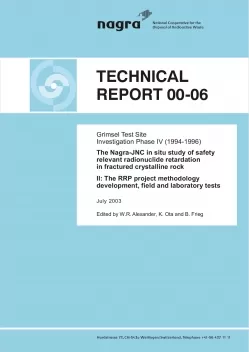
Technical Report NTB 00-06
Grimsel Test SiteInvestigation Phase IV (1994 – 1996):The Nagra-JNC in situ study of safety relevant radionuclide retardation in fractured crystalline rockII: The RRP project methodology development, field and laboratory tests
The Nagra-JNC Excavation Project (EP) was a very challenging project where, for the first time, a radionuclide cocktail of strongly sorbing radionuclides was injected into a water-conducting shear zone, followed by the excavation of the traced part of the shear zone (approximately two tonnes of rock). The development, improvement and testing of new methodologies and techniques were required due to the complexity of the project and to the scale of the in situ experiment. The extensive efforts which were undertaken in order to guarantee a successful experiment also required a series of laboratory and field tests (at Nagra's Grimsel Test Site, GTS), the latter wherever possible under conditions closely resembling the final experiment.
In this report, the preparation work for the shear zone immobilisation prior to overcoring and the evaluation of the appropriate solid phase analysis techniques following core recovery are presented in detail. Several existing immobilisation techniques were compared and the best compromise was found to be impregnation of the very friable shear zone with a two component epoxy resin (this was also shown to be capable of preserving the fault gouge within the shear zone). The most important criteria considered were viscosity, density, polymerisation time and constancy of the resin volume during polymerisation, wetting properties of water-wet surfaces in the pore space, homogeneous mixing with various dyes and limited sorption of radionuclides.
The physical properties were determined by the resin producers while the impregnation properties were investigated in the laboratory using wet crushed rock (Valanginian Marl) and then fault gouge material from the experimental shear zone. Wetting of the pore space was enhanced by injecting isopropanol prior to the resin injection (in effect replacing the pore water with isopropanol). In order to optimise the injection system, a suite of laboratory and smallscale field tests were performed at the GTS, examining various features of the system such as the applied injection pressure, the method of injecting isopropanol and how best to control the mixing ratio of the resin and hardener. This work revealed satisfactory pore space impregnation, with the resin penetrating open fractures and fault gouge zones at depth in the rock. Consequently, a larger scale field test was carried out to examine both shear zone impregnation over experimentally relevant distances and the subsequent overcoring methodology. The overcoring tests indicated that only a triple-barrel drillcore could guarantee full core recovery and that overcoring in the plane of the shear zone was much better than overcoring perpendicular to the shear zone.
Besides guaranteeing immobilisation of the shear zone, it was necessary that the resin did not disturb the existing radionuclide-rock distribution and so a series of sorption experiments was carried out on a suite of resins. Standard batch sorption experiments were carried out with resin impregnated rock samples and radionuclide-spiked groundwater from the shear zone to study potential competition between resin and granodiorite. In addition, to more precisely emulate the in situ conditions during the experiment, spiked rock samples were immersed in liquid epoxy resin, again to study potential competition between resin and granodiorite. The experiments clearly showed that resin impregnation would not significantly influence the in situ radionuclide distribution.
The assessment of surface analytical and radiochemical techniques for core analysis focussed on SIMS (secondary ion mass spectrometry) and LAM-ICP-MS (laser ablation microprobe – inductively coupled plasma – mass spectrometry). The studies were done using a range of samples from the experimental shear zone in order to evaluate the influence of surface roughness, charge neutralisation sample requirements and outgassing of impregnated samples. SIMS could obtain elemental distributions from mineral grains whereas, with LAM-ICP-MS measurements, pre-investigation with SEM (scanning electron microscopy) and BSEM (backscattered electron microscopy) proved necessary. Additional sample analysis using EMPA (electron microprobe analysis) showed that the technique provides reasonable results only on the rock (granodiorite) surfaces, while, in natural and synthetic fault gouge, a significant degree of beam-wandering made point analysis impossible. Quantitative analysis showed that most minerals have simple composition with little variation within a sample and should be a good internal standard for the laser ablation studies.
Finally, because of potential damage to the cores during sub-sampling, it was decided to assess the possibility of remotely investigating the shear zone structure (channelling, pore distribution, etc.) on the recovered core lengths. Several techniques were tested including PET (positron emission tomography) and MR (micro-resistivity). PET proved to be impractical due to sample size restrictions and very long counting times. In addition, relatively high activities were required to obtain high definition images. Nevertheless, it was felt that PET had good potential for real-time imaging of radionuclide transport through cores in the laboratory and that this would be worth further investigation. MR was also shown to have some promise but a complete lack of background information on MR applications to crystalline rock meant that a large research and development programme would have been necessary. As this was outwith the scope of the EP, it was decided not to take MR further.
This phase of work in the EP indicated that the full scale field experiment could proceed with a reasonable guarantee of a successful outcome using existing techniques adapted to the in situ conditions in the experimental shear zone (the full experiment is described in MÖRI et al. 2003a). In addition, some of the techniques developed here have since been applied in both JNC's Kamaishi Test Site in north-east Japan and in SKB's Äspö site in southern Sweden.
